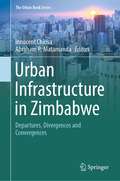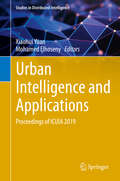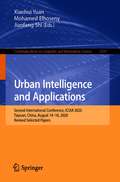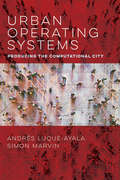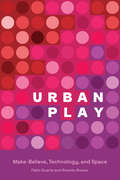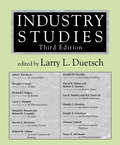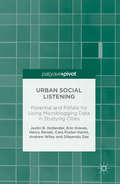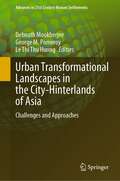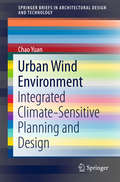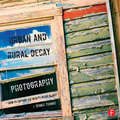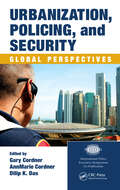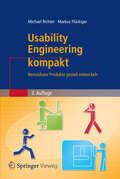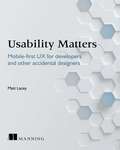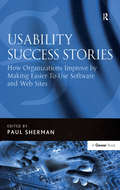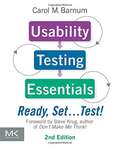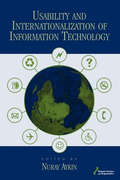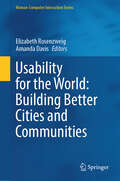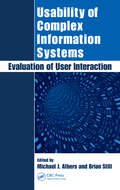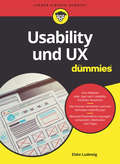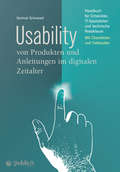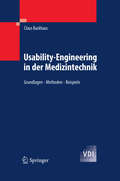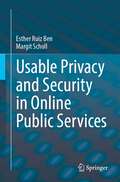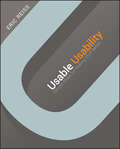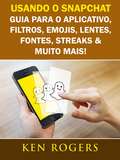- Table View
- List View
Urban Infrastructure in Zimbabwe: Departures, Divergences and Convergences (The Urban Book Series)
by Innocent Chirisa Abraham R. MatamandaThe book provides insights into urban infrastructure debates and discourses in Zimbabwe. Through an inter-disciplinary and multi-disciplinary approach, the book explores the theoretical, conceptual and lived experiences in urban infrastructure. The book focuses on case studies relating to urban transport, public housing, water and sanitation and Geographical Information Systems (GIS) among other substantive issues relating to urban infrastructure and services.
Urban Intelligence and Applications: Proceedings of ICUIA 2019 (Studies in Distributed Intelligence)
by Mohamed Elhoseny Xiaohui YuanThis volume presents selected papers from the International Conference on Urban Intelligence and Applications (ICUIA), which took place on May 10-12, 2019 in Wuhan, China. The goal of the conference was to bring together researchers, industry leaders, policy makers, and administrators to discuss emerging technologies and their applications to advance the design and implementation of intelligent utilization and management of urban assets, and thus contributing to the autonomous, reliable, and efficient operation of modern, smart cities. The papers are collated to address major themes of urban sustainability, urban infrastructure and management, smart city applications, image and signal processing, natural language processing, and machine learning for monitoring and communications applications. The book will be of interest to researchers and industrial practitioners working on geospatial theories and tools, smart city applications, urban mobility and transportation, and community well-being and management.
Urban Intelligence and Applications: Second International Conference, ICUIA 2020, Taiyuan, China, August 14–16, 2020, Revised Selected Papers (Communications in Computer and Information Science #1319)
by Mohamed Elhoseny Xiaohui Yuan Jianfang ShiThis book constitutes revised papers from the Second International Conference on Urban Intelligence and Applications, ICUIA 2020, held in August 2020. Due to the COVID-19 pandemic the conference was held online. The 26 papers were thoroughly reviewed and selected from 122 submissions. They are organised in the topical sections on technology and infrastructure; community and wellbeing; mobility and transportation; security, safety, and emergency management.
Urban Operating Systems: Producing the Computational City (Infrastructures)
by Simon Marvin Andres Luque-AyalaAn exploration of the modest potentials and serious contradictions of reconfiguring urban life through computational operating systems.A new wave of enthusiasm for smart cities, urban data, and the Internet of Things has created the impression that computation can solve almost any urban problem. Subjecting this claim to critical scrutiny, in this book, Andrés Luque-Ayala and Simon Marvin examine the cultural, historical, and contemporary contexts in which urban computational logics have emerged. They consider the rationalities and techniques that constitute emerging computational forms of urbanization, including work on digital urbanism, smart cities, and, more recently, platform urbanism. They explore the modest potentials and serious contradictions of reconfiguring urban life, city services, and urban-networked infrastructure through computational operating systems.
Urban Play: Make-Believe, Technology, and Space
by Fabio Duarte Ricardo AlvarezWhy technology is most transformative when it is playful, and innovative spatial design happens only when designers are both tinkerers and dreamers.In Urban Play, Fábio Duarte and Ricardo Álvarez argue that the merely functional aspects of technology may undermine its transformative power. Technology is powerful not when it becomes optimally functional, but while it is still playful and open to experimentation. It is through play--in the sense of acting for one's own enjoyment rather than to achieve a goal--that we explore new territories, create new devices and languages, and transform ourselves. Only then can innovative spatial design create resonant spaces that go beyond functionalism to evoke an emotional response in those who use them. The authors show how creativity emerges in moments of instability, when a new technology overthrows an established one, or when internal factors change a technology until it becomes a different technology. Exploring the role of fantasy in design, they examine Disney World and its outsize influence on design and on forms of social interaction beyond the entertainment world. They also consider Las Vegas and Dubai, desert cities that combine technology with fantasies of pleasure and wealth. Video games and interactive media, they show, infuse the design process with interactivity and participatory dynamics, leaving spaces open to variations depending on the users' behavior. Throughout, they pinpoint the critical moments when technology plays a key role in reshaping how we design and experience spaces.
Urban Politics: New York Style
by J. Bellush Dick NetzerIn many respects, New York City is an unnatural wonder, quite unlike any other American city and also unlike megacities in other industrial countries. Its government and politics, its physical attributes-like the celebrated skyline and high population density-and many of its social characteristics-like the extraordinarily high percentage of the city's population that is foreign-born-are different. But New York City at the same time shares with other American cities an array of political and governmental institutions, practices, traditions, and pressures, ranging from the long dominance and then long decline in the role of party organizations in local government to the city's ultimate dependence on outside actors and forces to shape its political destiny.
Urban Social Listening
by Justin B. Hollander Erin Graves Henry Renkski Cara Foster-Karim Andrew Wiley Dibyendu DasThis book analyses new software tools and social media data that can be used to explore the attitudes of people in urban places. It reports on the findings of several research projects that have have experimented with using microblogging data in conjunction with diverse quantitative and qualitative methods, including content analysis and advanced multivariate statistics. Applied researchers, planners and policy makers have only recently begun to explore the potential of Big Data to help understand social attitudes and to potentially inform local policy and development decisions. This book provides an original analysis into how Twitter can be used to describe the urban experience and people's perception of place, as well as offering significant implications for public policy. It will be of great interest to researchers in human geography, social media, cultural studies and public policy.
Urban Transformational Landscapes in the City-Hinterlands of Asia: Challenges and Approaches (Advances in 21st Century Human Settlements)
by George M. Pomeroy Debnath Mookherjee Le Thi Thu HuongIn the context of mounting challenges stemming from a rapid transformation of the urban-regional landscapes in many Asian countries, this book highlights a multifaceted array of issues that increasingly engage the academic and planning communities in search of viable solutions to complex problems facing us. Even though cities continue to dominate development studies, urbanization of Asia is evolving toward a hybrid urban-rural nexus beyond the cities. This volume considers these shifting dynamics of Asian urbanization, including urban spatial transformations and their ramifications in the context of sustainability and planning. Through the lens of a set of empirical studies across diverse disciplines, geographies and methodologies. yet with an overarching concern for sustainability in varied (but interconnected) areas such as climate change, land use planning, infrastructure and urban mobility, and quality of life, these studies examine a range of important topics (e.g., flooding, transportation, housing, open space/ green space, urban garden and such) in city/regional settings. Together, they add insights into varied transformational processes or patterns at work on the urban-regional landscapes in a number of Asian countries while offering innovative approaches or alternatives. The proposed volume fills a gap in urban/regional studies in context of South and Southeast Asia that will be of interest to all stakeholders (e.g., planners, administrators, academicians and the citizenry), particularly those interested in sustainability and planning paradigms. It should be a timely and valuable addition to the Asian urbanization literature.
Urban Wind Environment: Integrated Climate Sensitive Planning And Design (Springerbriefs In Architectural Design And Technology Ser.)
by Chao YuanIn the context of urbanization and compact urban living, conventional experience-based planning and design often cannot adequately address the serious environmental issues, such as thermal comfort and air quality. The ultimate goal of this book is to facilitate a paradigm shift from the conventional experience-based ways to a more scientific, evidence-based process of decision making in both urban planning and architectural design stage. This book introduces novel yet practical modelling and mapping methods, and provides scientific understandings of the urban typologies and wind environment from the urban to building scale through real examples and case studies. The tools provided in this book aid a systematic implementation of environmental information from urban planning to building design by making wind information more accessible to both urban planners and architects, and significantly increasing the impact of urban climate information on the practical urban planning and design. This book is a useful reference book to architectural postgraduates, design practitioners and planners, urban climate researchers, as well as policy makers for developing future livable and sustainable cities.
Urban and Rural Decay Photography: How to Capture the Beauty in the Blight
by J. Dennis ThomasIf you are a photographer who sees the beauty in abandoned buildings, crumbling facades, and preserving a fading history, and who also has a love of urban exploration, you have stumbled on a must-have for your photographic library. Urban and Rural Decay Photography offers expert tips and techniques for capturing breathtaking photographs of your favorite decay scenes, whether in urban or rural settings. Author J. Dennis Thomas guides you through the history of decay photography, shows you what equipment you will need, and discusses digital, film and HDR capture and composition. The book addresses which artistic considerations work best for the kinds of shots that capture a moment and convey a story. He also provides you with important safety advice and matters of the law when entering and working with decaying structures. Chock full of inspiring images that will ignite your creativity and your passion for decay photography, Urban and Rural Decay Photography is just the book you need to get you out and discovering your newest urban or rural exploration adventure.
Urbanization, Policing, and Security: Global Perspectives (International Police Executive Symposium Co-Publications)
by Gary Cordner Dilip K. Das AnnMarie CordnerIn terms of raw numbers, the amount of world urban dwellers have increased four-fold, skyrocketing from 740 million in 1950 to almost 3.3 billion in 2007. This ongoing urbanization will continue to create major security challenges in most countries. Based on contributions from academics and practitioners from countries as diverse as Nigeria, Pakist
Usability Engineering kompakt
by Markus D. Flückiger Michael RichterUsability Engineering spielt überall dort eine Rolle, wo Benutzer mit technischen Systemen zu tun haben. Welche Faktoren bestimmen, ob wir mit einem Produkt sehr einfach, nur schwer oder gar nicht zum Ziel kommen? Welche Möglichkeiten bieten sich, diese Faktoren in der Entwicklung systematisch in den Griff zu bekommen? Dieses Buch vermittelt einen leicht verständlichen Einstieg in die Praxis und bietet Ihnen das Wichtigste übersichtlich zum Nachschlagen: Die wichtigsten MethodenUmsetzung im EntwicklungsprozessUsability und Requirements EngineeringStrategie im UnternehmenPlanung, Durchführung und KontrolleChecklisten, Praxisbeispiele, DenkanstößeFallstudien aus durchgeführten Projekten Die dritte Auflage wurde durchgehend überarbeitet und um die Themen Agile Software-Entwicklung und Mobile User Experience erweitert.
Usability Matters: Mobile-first UX for developers and other accidental designers
by Matt LaceySummaryUsability Matters: Mobile-first UX for developers and other accidental designers gives you practical advice and guidance on how to create attractive, elegant, and useful user interfaces for native and web-based mobile apps. Purchase of the print book includes a free eBook in PDF, Kindle, and ePub formats from Manning Publications.About the TechnologyJust because a mobile app works doesn't mean real people are going to like it. Usability matters! Most mobile developers wind up being part-time designers, and mastering a few core principles of mobile UI can make the difference between app and crap. About the BookUsability Matters is a guide for developers wrestling with the subtle art of mobile design. With each expertly presented example, app developer and designer Matt Lacey provides easy-to-implement techniques that instantly boost your design IQ. Skipping highbrow design theory, he addresses topics like gracefully handling network dropouts and creating intuitive data inputs. Read this book and your apps will look better, your users will be happier, and you might even get some high-fives at the next design review. What's InsideUnderstanding your users Optimizing input and output Creating fast, responsive experiences Coping with poor network conditions Managing power and resources About the ReaderThis book is for mobile developers working on native or web-based apps. About the AuthorMatt Lacey is an independent mobile developer and consultant and a Microsoft MVP. He's built, advised on, and contributed to apps for social networks, film and TV broadcasters, travel companies, banks and financial institutions, sports companies, news organizations, music-streaming services, device manufacturers, and electronics retailers. These apps have an installed base of more than 500,000,000 users and are used every day around the world.Matt previously worked at a broad range of companies, doing many types of development. He has worked at startups, small ISVs, national enterprises, and global consultancies, and written software for servers, desktops, devices, and industrial hardware in more languages than he can remember. He lives in the UK with his wife and two children. Table of Contents IntroductionPart 1 - ContextWho's using the app?Where and when is the app used?What device is the app running on?Part 2- InputHow people interact with the appUser-entered dataData not from a userPart 3 - OutputDisplaying items in the appNon-visible outputPart 4 - ResponsivenessUnderstanding the perception of timeMaking your app start fastMaking your app run fastPart 5 - ConnectivityCoping with varying network conditionsManaging power and resources
Usability Success Stories: How Organizations Improve By Making Easier-To-Use Software and Web Sites
by Paul ShermanPeople spend increasing amounts of time and effort interacting with complex hardware and software products. Some of the products we interact with are easy to learn and easy to remember. Some are even a pleasure to use. Others are hard to learn, hard to use, and frustrate us at every turn. But it is not just the user that pays the cost in such cases. Poor usability also imposes significant costs on product producers. Companies that make hard-to-use products incur higher support costs, spend more on rework, and have less satisfied customers. These outcomes can be avoided by applying the techniques of usability engineering and user-centred design (UCD) during product development. This book shows how usability and UCD practitioners do this by studying users' needs and abilities, designing the product accordingly, and verifying the design through additional testing with users. Despite the positive return on investment for usability engineering activities, many organizations view usability engineering as a non-critical part of the product development process. This book seeks to change this by relating a number of cases where usability engineering contributed significantly to the solution of a business problem. Evidence is drawn from experiences within a range of private and public sector organizations showing how usability work can best be organized and executed within a business environment. The organizational factors that facilitate or impede the application of usability engineering are also discussed. The book clearly explains the barriers to be overcome as well as highlighting the factors promoting success. A wide range of applications are covered, including web-based e-commerce, medical devices and software, process control management systems, financial services applications, consumer desktop applications and interactive voice response systems. Usability Success Stories provides a valuable guide for business managers and technical staff as well as for practitioners within the field itself.
Usability Testing Essentials: Ready, Set ...Test!: Ready, Set...Test!
by Carol M. BarnumUsability Testing Essentials presents a practical, step-by-step approach to learning the entire process of planning and conducting a usability test. It explains how to analyze and apply the results and what to do when confronted with budgetary and time restrictions. This is the ideal book for anyone involved in usability or user-centered design―from students to seasoned professionals. Filled with new examples and case studies, Usability Testing Essentials, Second Edition is completely updated to reflect the latest approaches, tools and techniques needed to begin usability testing or to advance in this area. Provides a comprehensive, step-by-step guide to usability testing, a crucial part of every product’s development Discusses important usability issues such as international testing, persona creation, remote testing, and accessibility Presents new examples covering mobile devices and apps, websites, web applications, software, and more Includes strategies for using tools for moderated and unmoderated testing, expanded content on task analysis, and on analyzing and reporting results
Usability and Internationalization of Information Technology (Human Factors and Ergonomics)
by Nuray AykinToday, more and more Web sites are providing content in multiple languages for targeted countries, and more and more products are being designed for cultural differences in mind. However, the concept of cross-cultural design has not yet become a strong force in the practitioners' and educators' agenda. This book looks at techniques, software, tools
Usability for the World: Building Better Cities and Communities (Human–Computer Interaction Series)
by Amanda Davis Elizabeth RosenzweigWant to build cities that truly work for everyone? Usability for the World: Sustainable Cities and Communities reveals how human-centered design is key to thriving, equitable urban spaces. This isn't just another urban planning book; it's a practical guide to transforming cities, offering concrete strategies and real-world examples you can use today. What if our cities could be both efficient and human-friendly? This book tackles the core challenge of modern urban development: balancing functionality with the well-being of residents. It explores the crucial connection between usability and sustainability, demonstrating how design principles, from Universal to life-centered, create truly livable cities. Interested in sustainable urban development? Usability for the World offers a global perspective, showcasing diverse approaches to creating equitable and resilient cities. Through compelling case studies, discover how user-centered design addresses pressing urban challenges. See how these principles connect directly to achieving the UN Sustainable Development Goals, specifically SDG 11: Sustainable Cities and Communities. This book offers more than theory. It provides practical insights and actionable strategies for: Designing user-centered cities: Apply usability principles to urban planning. Improving urban spaces: Discover how tech and innovation create human-friendly environments. Building sustainable communities: Explore the link between human-centered design and the SDGs. Creating equitable cities: Understand how design promotes inclusivity and accessibility. Whether you're an urban planner, designer, policymaker, or simply someone who cares about our cities' future, Usability for the World provides the tools and inspiration you need. Join the movement to build better cities, one human-centered design at a time. What will your contribution be to the future of urban living?
Usability of Complex Information Systems: Evaluation of User Interaction
by Michael J. Albers Brian StillWhy do enterprise systems have complicated search pages, when Google has a single search box that works better? Why struggle with an expense reimbursement system that is not as easy as home accounting software? Although this seems like comparing apples to oranges, as information and communication technologies increasingly reach into every industry
Usability und UX für Dummies (Für Dummies)
by Elske LudewigSie erstellen eine Website und wissen nicht, wie Sie sie sinnvoll aufbauen und designen? Sie möchten Ihre Kunden länger auf Ihrer Website halten? Sie träumen davon, dass mehr Kunden den Kaufen-Button klicken? Steigen Sie mit diesem Buch in das Thema "Benutzerfreundlichkeit" und "Positives Nutzererlebnis" ein. Führen Sie Ihre Kunden schnell und einfach zu ihrem Ziel, vermitteln Sie ihnen ein positives Gefühl und machen Sie ihnen die Kaufentscheidung leicht. Fangen Sie bei der Lesbarkeit der Texte an, achten Sie auf die Auffindbarkeit wichtiger Funktionen und lernen Sie, wie man benutzerfreundliche Formulare entwickelt. Was bei mobilen Websites und Apps anders ist, erfahren Sie natürlich auch.
Usability von Produkten und Anleitungen im digitalen Zeitalter: Handbuch für Entwickler, IT-Spezialisten und technische Redakteure
by Gertrud GrünwiedTechnische Produkte können nur erfolgreich sein, wenn die Gebrauchstauglichkeit, die Usability, frühzeitig im Entwicklungsprozess geplant und in allen Produktphasen verankert wird. Dies betrifft smarte Geräte, Softwareprodukte, Webanwendungen und Apps genauso wie komplexe und umfangreich dokumentierte Maschinen, Fahrzeuge und Systeme. In ihrem Buch vermittelt Gertrud Grünwied eine ganzheitliche Sicht auf intuitiv bedienbare Produkte und deren Anleitungen. Sie bietet das relevante Know-how zu User-Centered Design und eine Übersicht zur Auswahl von Usability-Methoden. Usability-Maßnahmen beschreibt sie schrittweise von der Planung, der Durchführung und Auswertung bis zur Optimierung von Produkt und Anleitung. Der Praxisteil präsentiert Fallstudien für Anleitungen mit und ohne Produkt sowie für eine Dienste-App im Internet, außerdem eine Betrachtung zu Kosten, Nutzen und Implementierungszeitpunkt von Usability-Methoden. Die dargestellten Usability-Maßnahmen erstrecken sich nicht nur auf das technische Produkt selbst, sondern auch auf die Nutzungssituation und die smarte Benutzerinformation, zum Beispiel das Nachschlagen in der Bedienungsanleitung zur Fehlerbehebung, Dokumentations-Apps zum Kennenlernen von Systemfunktionen oder das Üben und Lernen anhand einer Produktsimulation per Video-Tutorial oder Animation. Damit richtet sich das Buch an alle Mitarbeiter produzierender Unternehmen und ihrer Dienstleister, die an Usability-Aspekten beteiligt sind - Produktmanager, Entwickler, IT-Spezialisten, Designer, Technische Redakteure und Mitarbeiter in Schulung und Service, aber auch an Studierende der Informatik und Ingenieurwissenschaften einschließlich Technischer Redaktion und Kommunikation. Inhalt: Anforderungen an Usability von Produkten und Anleitungen "4.0" - Prozesse und Planung - Nutzer- und Nutzungsforschung - Gestaltung - Evaluation - Anwenden der Methoden und ihre Wirtschaftlichkeit - Fallstudien - Software-Tools und Normen
Usability-Engineering in der Medizintechnik
by Claus BackhausErgonomisch gestaltete Medizintechnik führt zu effizienteren Arbeitsabläufen, erhöht die Patientensicherheit und reduziert die Arbeitsbelastung. Das Buch erläutert, wie Medizintechnik an die Bedürfnisse der Nutzer und Anwender angepasst werden kann. Durch das beschriebene Vorgehen ist es möglich, sowohl die Anforderungen der harmonisierten Normen DIN EN 62366 und DIN EN 60601-1-6 umzusetzen als auch neue Lösungsansätze für die Entwicklung innovativer Medizintechnik zu erarbeiten. Die Umsetzung wird anhand ausgewählter Praxisbeispiele erörtert.
Usable Privacy and Security in Online Public Services
by Esther Ruiz Ben Margit SchollThis practice-oriented book is a unique guide to the implementation of usable, privacy-compliant and secure online services in the area of e-government. Beginning with a clarification of basic concepts of usability, data privacy, and cybersecurity, the book provides lucid explanations of different methods (quantitative, qualitative, and mixed methods) that can be applied in the practice of designing, developing, and evaluating online public services in light of both usability criteria and data privacy and IT security compliance. A number of examples and exercises are included as well as awareness-raising measures that can serve as orientation both for practitioners and for teaching purposes. There is also a concise glossary of terms along with recommendations for further reading.This book provides comprehensive coverage of usability, data privacy and information security topics. At the time of going to press, it is also up to date with respect to the implementation of the EU Single Digital Gateway regulation. It is therefore aimed at anyone interested in understanding the principles of usable privacy and information security and in ways of contributing to the design, development, and evaluation of online public services that satisfy the needs of the public. The book’s audience thus includes not only students in the areas of e-government or public administration but also professionals developing online services or e-government applications.
Usable Usability: Simple Steps for Making Stuff Better
by Eric ReissThe A-to-Z guide to spotting and fixing usability problems Frustrated by pop-ups? Forms that make you start over if you miss a field? Nonsensical error messages? You're not alone! This book helps you simply get it right the first time (or fix what's broken). Boasting a full-color interior packed with design and layout examples, this book teaches you how to understand a user's needs, divulges techniques for exceeding a user's expectations, and provides a host of hard won advice for improving the overall quality of a user's experience. World-renowned UX guru Eric Reiss shares his knowledge from decades of experience making products useable for everyone...all in an engaging, easy-to-apply manner. Reveals proven tools that simply make products better, from the users' perspective Provides simple guidelines and checklists to help you evaluate and improve your own products Zeroes in on essential elements to consider when planning a product, such as its functionality and responsiveness, whether or not it is ergonomic, making it foolproof, and more Addresses considerations for product clarity, including its visibility, understandability, logicalness, consistency, and predictability Usable Usability walks you through numerous techniques that will help ensure happy customers and successful products!
Usando o Snapchat: Guia para o Aplicativo, Filtros, Emojis, Lentes, Fontes, Streaks & Muito Mais!
by Ken Rogers André RodriguesUm guia passo a passo sobre como usar e dominar o Snapchat. Aprenda a enviar mensagens, usar bitmojis, editar snaps, criar stories, transferir dinheiro e muito mais!
Use ClickOnce to Deploy Windows Applications
by Wei-Meng LeeClickOnce, a new technology in Visual Studio 2005, lets you quickly and easily deploy your Windows apps via web servers, file servers, or even CDs. But while ClickOnce delivers web-style deployment of your application, that's only part of the story. Once you've installed an application using ClickOnce, it can automatically check for new updates to the application, which saves time in application maintenance and upgrades. And on the security front, a ClickOnce application runs within a secure sandbox and you configure it using the Code Access Security model. So, how can you take advantage of this new technology? In this step-by-step guide to using ClickOnce, you'll learn how to create an application in Visual Studio 2005 and how to use ClickOnce to quickly get it in the hands of your customers. You'll also learn how to add security to your distributions using Code Access Security; how to update COM files without corrupting DLLs; and more.
